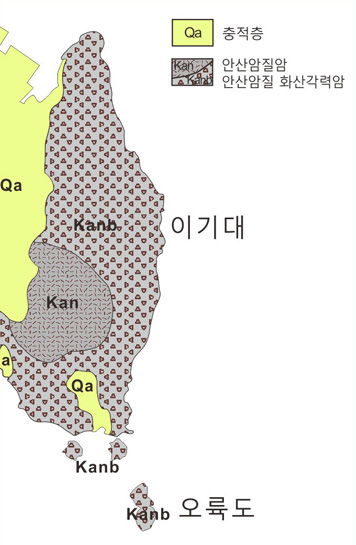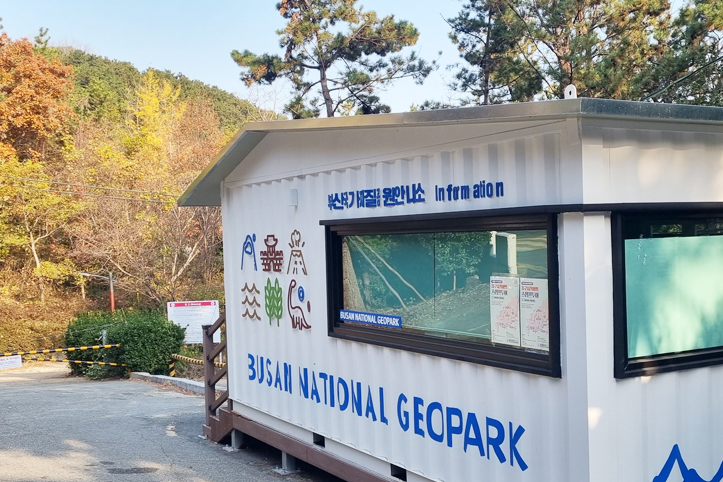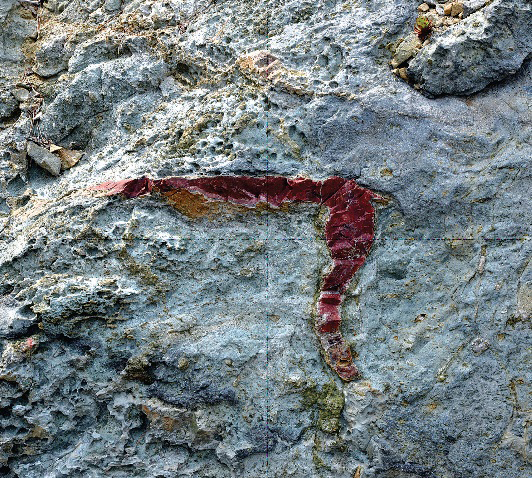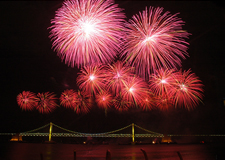Igidae Coastal Walkway ▪ 3.95㎞ ▪ Average 2 hours
- A masterpiece path on the cliffs by the sea
- Part of Busan Galmaet-gil Couse 9
- Course: Dongsaengmal Trail → Eoul Madang → Nongbawi Rock → Oryukdo Sunrise Park

The cliff provides magnificent natural views with sea cliffs, wave-cut terraces and sea caves shaped by waves pounding against the various volcanic rocks and sedimentary rock strata, comprising lava, volcanic ash and pyroclastic flow from intense andesitic volcanic activity 80 million years ago.
On the trail course along the coast leading to Oryukdo Islands, you can appreciate the various geological, geographical and topographical landscapes of a copper mine, potholes, horsetail structure, and Hornblende megacrysts-bearing dikes.
By a powerful eruption of andesitic volcanoes 80 million years ago, volcanic ash and pyroclastics where topped and eroded by wave action to create grand sea cliffs, wave-cut platforms, and sea caves.
“Igidae” refers to the platform located on the eastern coast where Jangsanbong Peak faces the sea belonging to Yongho3-dong. It is located just beyond the hill of Yongho Sewage Treatment Plant. The sea east of Jangsanbong Peak (22.3m) is dangerous for public access, albeit with an outstanding landscape due to oddly-shaped rock cliffs and beautiful scenery that can be observed by boat. However, Igidae Cliff is located where the slanting bedrock sinks into the sea, and the location it is sitting on is similar almost to the flat surface that stretches about 2km to the sea in parallel with the mountain. With an outstanding view of surging waves and the East Sea, it is also a great place for fishing and taking in superb sunrises and sunsets. Restriction on civilian access, due to the area’s former status as an military operation zone, was lifted in 1993 when it was opened to the public. The name Igidae can be found in the 『Records of Dongnae Camp』.
The 『Records of Dongnae Camp』 is a collection and supplementation of the previous records written by Yi Hyeongha, Navy Commander of Left Gyeongsang-do (held office between Dec. 30, 1849 and Aug. 21, 1850), containing detailed description of history and geography of the Navy Command of Left Geongsang-do. Igidae appears in the Sancheon Section of this book, which says, “Igidae is located 6km south of the Navy Command of Left Geongsang-do. It is referred to as such because there are two gisaeng (Korean geisha) graves there.
According to local historian Choe Hanbok (1895∼1968; born in Suyeong), during the Japanese Invasion of Korea in 1592, Japanese troops took Suyeongseong Fortress and held a feast to celebrate this beautiful place, in which two gisaeng from Suyeong participated. They served wine to the Japanese generals, fell down to the water with them and died. It is said the name Igidae comes from this story.
“Igidae” is the platform located on the eastern coast where Jangsanbong Peak faces the sea. The name Igidae appears in the Sancheon Section of the 『Records of Dongnae Camp』: “Igidae is located 6km south of the Navy Command of Left Geongsang-do. It is referred to as such because there are two gisaeng (Korean geisha) graves there.” During the Japanese Invasion of Korea in 1592, Japanese troops took Suyeongseong Fortress and held a feast to celebrate this beautiful place, in which two gisaeng from Suyeong participated. They served wine to the Japanese generals, fell down to the water with them and died. It is said the name Igidae comes from this story.
※ Access is restricted when it is snowy, rainy and very windy.

Sword-leaf crepidiastru, a herbaceous perennial belonging to the chrysanthemum family, grows in cracks in rocks on the seashore with leaves and sprouts eaten as a vegetable dish. Leaves are split in feather form that are thicker and tougher than those of Korean lettuce. Several yellow flowers hang from the ends of the stems in the late autumn.

Boehmeria pannosa, a herbaceous perennial belonging to the Urticaceae family, is distributed on the southern coast of Korea. Its abundant leaves are thick and hairy to prevent transpiration due to frequent prevailing winds on the seashore. Due to its robust fibers on the skin of the stems, it was used as a material for “ramie” fabric.

Erecta fig, a deciduous shrub belonging to the Moraceae genus, grows on the southern coast of Korea. The name Erecta fig means fruit eaten by heavenly Taoist immortals. It is similar to regular figs and can be eaten when it ripens into a dark purple in Aug.~Sept.

Aster spathulifolius, a perennial herb of the chrysanthemum family that grows in cracks in seashore rocks or mountains, is a common sight along the Busan seashore. Its violet flowers blooming in clusters in the autumn are a beautiful sight.

The Igidae and Oryukdo areas comprise volcanic rocks and tuffaceous sedimentary rocks made by lava, volcanic ash and pyroclastic flow from intense volcanic activity in the late Cretaceous period of the Mesozoic Era, about 80 million years ago.
In particular, the Igidae coast and Oryukdo quay are well-developed volcanic breccias, tuffaceous sedimentary rock and dikes that broke through these rocks and rose up.

Located in the Igidae Park Management Office at the entrance to Igidae, the center provides information on geological attractions and geotrails of Igidae Cliff. Leaflets on Busan Geopark and Igidae trails in the cetner will help you understand the geological attractions.

Vantage point for viewing Busan’s tourist attractions of Gwangan Bridge, Nurimaru and Haeundae, well-known as the filming location of “Haeundae.”

Dinosaur footprint-like forms appear on volcanic breccias on the seashore. They are potholes made by erosion from pebbles and sand moving with the waves.

There were five copper mine shafts around this area during the Japanese colonial era, one of which is this mine whose bottom was 55m in width and 380m in length. A great quantity of 99.9% pure brass was produced at that time, but the shaft entrance is now closed.

Place for women divers’ resting or storing fishing gear after they finish their work. Women Divers’ Shelter is infused with the joys and sorrows of people living with Igidae as the basis for their livelihood. The shelter was made by laying stones on the turtle head-shaped rock.

Natural caves made as vulnerable parts or gaps of rocks making up precipitous cliffs were cut away by waves over a long period. Sea caves on Igidae Cliff are exposed on land, therefore, enabling them to be observed and experienced.

Dikes that broke through vulnerable parts or gaps through venation and rose up can be observed. The dikes here are found to contain a large quantity of big crystals of amphibole, a colored mineral.

Andesitic volcanic breccias piled up due to explosive volcanic eruptions during the Cretaceous period are widely developed along the trail.

This object, looking as if painted in red on the volcanic breccias, is the gem mineral Jasper. It emerges like veins from volcanic rocks or tuff formed by volcanic eruptions.

Bedding where volcanic ash-mixed sedimentary rocks (sandstone and mudstone) are stacked in sequence during the dormant period after explosive volcanic activity.

Unhampered views and the sound of moving pebbles can be enjoyed while walking on the suspension bridge (length: 127m). Five such bridges span the coastal cliffs, which represents Igidae Cliff.

Oryukdo Islands, six islands gathered in a cluster, refresh the eyes and calm the breath with endless sea. The name Oryukdo is derived from the islands’ looking like five or six depending on the ebb and flow of the tides
| Festival name | Hosting month | Location | Official contact No. |
|---|---|---|---|
| Igidae Moon-Viewing Festival | the 15th of the New Year according to the lunar calendar | Igidae Eoul Madang | 051-607-4062 |
| Busan International Performing Arts Festival | May | Busan Cultural Center, etc. | 010-625-2711 |
| Oryukdo Festival | May | Baegunpo Sports Park and Peace Park, etc. | 051-607-4062 |
| Igidae Firefly Festival | June | Igidae Waterfront Park | 051-607-4382 |
| Busan Fireworks Festival | October | around Gwangalli Beach | 051-888-3392 |
| Information center | Official contact No. | Information center | Official contact No. |
|---|---|---|---|
| Busan Station Tourist Information Center | 051-441-6565 | International Passenger Terminal | 051-465-3471 |
| Gimhae Airport (International Terminal) Tourist Center | 051-973-2800 | Gimhae Airport (Domestic Terminal) Tourist Center | 051-973-4607 |
| Suyeong Tourist Information Center | 051-610-4216 | UN Memorial Park Tourist Information Center | 051-625-1608 |
| Busan Tourist Information Center for Foreigners | 051-441-3121 | Oryukdo Haeparang Tourist Information Center | 051-607-6395 |

UN Memorial Park, the world’s only cemetery for UN Forces, honors the service and sacrifice of the UN forces in the pursuit of world peace and freedom. (State-designated Registered Cultural Property No. 359) With the greater significance of memorializing the Korean War, the UN Memorial Park began construction under UN Forces Command in January, 1951, the year after the war, for burial of fallen soldiers. With construction completed in April of the same year, the remains of fallen UN soldiers temporarily buried in Gaeseong, Incheon, Daejeon, Daegu, Miryang and Masan began to be relocated to the Park. Currently, 2,300 fallen soldiers from the US, UK and Turkey have been laid to rest there. The main gate, designed by Artichect Kim Jungeop, represents Korea’s traditional modeling in abstract form, while the interior of the Memorial Hall was designed to cherish the significance of 16 nations. The exterior of the building was designed based on multi-national and religious perspectives.
| Viewing hours | Others | |
|---|---|---|
| Oct. ~ Apr. | 09:00~17:00 |
|
| May ~ Sept. | 09:00~18:00 | |

Daeyeon Arboretum, an exhibition garden with a 50m-wide green zone surrounding the UN Park in Daeyeon-dong, Nam-gu, includes Herb Garden, Coniferous Forest Garden, Oryukdo Garden, Water Curtain Garden, Deciduous Tree Garden, Evergreen Broad-leaved Tree Garden, Bamboo Grove Garden, Mugunghwa (hibiscus) Reference Garden and Fruit Tree Garden. You can experience about 600 varieties of trees exhibited according to ecology, value of nature and biological diversity. Further, being connected with Busan’s premier cultural tourism belt, Daeyeon Arboretum offers families, students and other visitors a perfect day out for rest and nature immersion.

Peace Park is located south of the UN Memorial Park. Before the park was constructed, the site was home to 51 environment-impacting businesses, such as scrap metal treatment, car maintenance, truck parking and freight transportation, spoiling the urban landscape with noise, dust and soil contamination. Now, it is home to a symbolic park that honors the commitment to freedom and improved quality of life for local residents. It was included in the list of places visited by dignitaries during the “2005 APEC Economic Leaders’ Meeting”.

The museum exhibits Korean cultural heritage from prehistoric times to the present. It serves to improve citizens’ understanding of our culture and provide related data to professional researchers. It also facilitates academic investigation of prehistoric, ancient and medieval culture of the Busan area, with excavated relics stored there after preservation treatment. Further, as a cultural and resting space for citizens, the museum raises cultural awareness and promotes social education.
| Weekdays and Sunday | every Saturday, last Wednesday of each month |
Closed |
|---|---|---|
| 09:00-18:00(Entry until 17:00) | 09:00-21:00(Entry until 20:00) | Closed every Monday and Jan. 1 |

Gwalli Beach extends from Namcheon-dong in the west to Millak-dong in the east. The endless sandy beach is a major tourist attraction alongside Haeundae Beach. In addition to restaurants with unique ambience, there are about 300 raw fish restaurants, a raw fish center, Eonyang Bulgogi (barbequed beef), Bean Sprout Hangover Soup Alley and Café Street by the beach. With various performances on a regular basis on the beach’s permanent outdoor stage, a range of marine sports including Banana boat and wind surfing can be enjoyed at the waterfront park, beach park, Youth Training Center and Marine Leisure Sports Center nearby. It is a key tourist drawcard with more than 30 million tourists visiting every year, 10 million of which flood in from home and abroad during the summer. Gwalli Beach has cemented its position as a Busan landmark along with Gwangan Bridge, Busan New Media Art Museum and Busan Fireworks Festival.